The Apple Thunderbolt Display Review
by Anand Lal Shimpi on September 23, 2011 2:56 AM EST- Posted in
- Displays
- Mac
- Apple
- Thunderbolt
- Thunderbolt Display
Ever since I moved to a notebook as my main work computer I've become increasingly annoyed with the process of actually moving my notebook-as-a-desktop around. At my desk I've got DisplayPort, Ethernet, two USB, FireWire 800, speakers and power all plugged into a 15-inch MacBook Pro. What makes it frustrating isn't the first-world-problem of having to unplug seven cables, rather that it doesn't need to be seven cables - Apple could make the whole thing happen with just two.
Every Mac released in 2011 has at least one Thunderbolt port (the iMac has two), and Thunderbolt can deliver exactly what I'm looking for. Thunderbolt can carry two things: PCI Express and DisplayPort, the former for data and the latter obviously for video. Why would you want to carry PCIe and DP over a single cable? To address problems like the one above.
Pretty much all device expansion on modern day PCs happens via PCI Express. Several years ago it was hard to find PCIe sound cards or Ethernet controllers, but these days vanilla PCI slots are nearing extinction and PCIe is the de facto standard. Ethernet, USB and FireWire controllers all exist as single-lane PCIe devices. Put a bunch of them at the other end of a Thunderbolt cable and you no longer need to plug in a bunch of individual cables into your notebook when at your desk. Send DisplayPort over the same cable and you can actually move all of those ports onto your monitor, thereby using a single cable to carry everything but power to your display. And this is exactly what Apple has done with its new Thunderbolt Display. By mating its 27-inch LED Cinema Display with a bunch of integrated IO controllers, Apple is hoping to deliver a display that's more of a mobile docking station than just a passive way to display video.
Apple has tried this in the past. The old Cinema Displays used to feature an Apple Display Connector (ADC) that actually carried DVI, USB and power from a desktop Mac to the monitor. You only needed to plug in a single cable to your display, significantly reducing desktop clutter. Although Thunderbolt does carry power, it's limited to 10W - not enough to power any reasonably sized display. Where Thunderbolt does win out over ADC however is in its universal appeal. Intel created the standard. Although it's used almost exclusively on Apple systems today, come 2012 Intel is expecting PC OEMs to embrace the interface with its Cactus Ridge line of Thunderbolt controllers.

Apple's Thunderbolt Display
The Thunderbolt Display uses a near, if not perfectly, identical panel to what was in last year's 27-inch LED Cinema Display. You get a 27-inch, 16:9, 2560 x 1440 LED backlit display capable of at least 350 nits at full brightness. Apple seems to conservatively spec its desktop displays as we were able to measure 425 nits at max brightness. The uber brightness comes in handy because the display does have a glossy finish. Indoors it's not really a problem unless you're watching a dark movie scene with the display lit by a sun-facing window. Even then, cranking up the brightness all the way is usually enough to overcome any significant glare. As with all glossy displays, if you have light control (e.g. curtains or blinds) you'll be just fine.
The similarities don't end with the internal panel, the chassis is very similar to its older sibling and the Thunderbolt Display retails for the same $999 price.
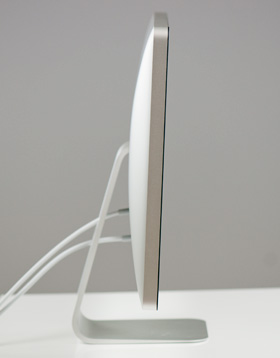 |
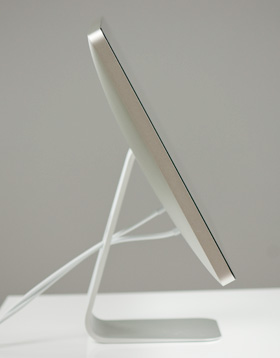 |
The display sits on an aluminum swivel base that allows for -5 degrees to 25 degrees of tilt along the horizontal axis. There's no height adjustment for the display either, only tilt. Personally, I use a height adjustable desk as I find it helps me avoid any carpal tunnel pain. Combined with a height adjustable chair, the lack of height adjustment on the display doesn't bother me. If you have a fixed height desk however, this may be a problem.
Aesthetically the Thunderbolt Display continues Apple's aluminum meets glass design language. The front of the display is all glass, while the edges and back are all aluminum. Along the top surface of the display is a mic for the integrated FaceTime HD camera. The outgoing 27-inch LED Cinema Display (still available for purchase online) sported a 640 x 480 camera, while the Thunderbolt Display ups capture resolution to 1280 x 720.
There's an ambient light sensor hidden in the top bezel of the display, but as always you can disable its functionality from within OS X.

There are two integrated speakers in the display, again unchanged from the previous LED Cinema Display.
Two cables attach directly to the display: a removable power cable and an integrated IO cable. Cable management is done through a round cutout in the aluminum stand. The IO cable is where things really change with the Thunderbolt Display. Instead of a breakout of three cables as was the case with the Cinema Display, there are now only two: MagSafe and Thunderbolt.
The MagSafe connector remains unchanged. If you've got any Mac that can be charged by an 85W MagSafe adapter, the Thunderbolt Display will charge said Mac. This feature alone is particularly awesome for notebook-as-a-desktop users since it allows you to just keep your actual AC adapter tucked away in your travel bag. For me I keep my MagSafe adapter in my bag and never take it out so I never have to worry about forgetting to pack it. Given how expensive MagSafe adapters are ($79 for an 85W), this is a nice feature for MacBook Air/Pro owners.
The Thunderbolt cable is obviously what gives this new display its name. Inside the Thunderbolt Display is an Intel Light Ridge Thunderbolt controller. The type of controller is important as it bestows upon the display some clear limitations. The biggest of course is the lack of support for all non-Thunderbolt systems. That's right, the only way to get video to the Thunderbolt Display is by using a Thunderbolt enabled Mac (or theoretically a Thunderbolt enabled PC). For Mac users that means only 2011 MacBook Pro, Air, iMac or Mac mini models will work with the Thunderbolt Display. Everyone else has to either buy a new Mac or stick with older displays.
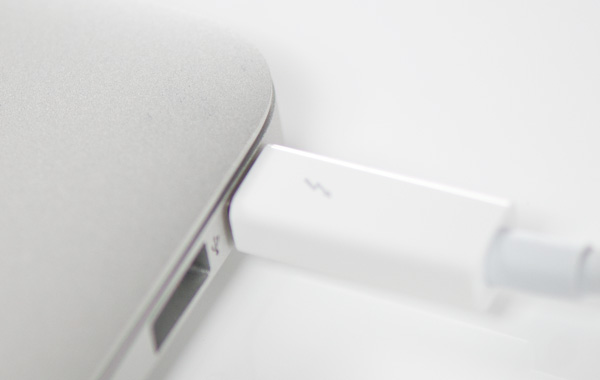
I believe the limitation here is actually on the cable side. A Thunderbolt cable can only transmit a Thunderbolt signal. Although DisplayPort is muxed in, if the display on the other end is expecting Thunderbolt and it receives DisplayPort it won't know what to do with it. It's possible Apple could have built in logic to autosense and switch between Thunderbolt and DisplayPort as inputs, but Apple traditionally employs clean breaks rather than long technology transitions. If Apple wants to ensure Thunderbolt gets adopted (at least by its users), this is the way to do it. As we learned from other legacy interfaces (e.g. PS/2, IDE), if you enable backwards compatibility you'll ensure the survival of systems that implement those interfaces. It's not so great for existing customers unfortunately.


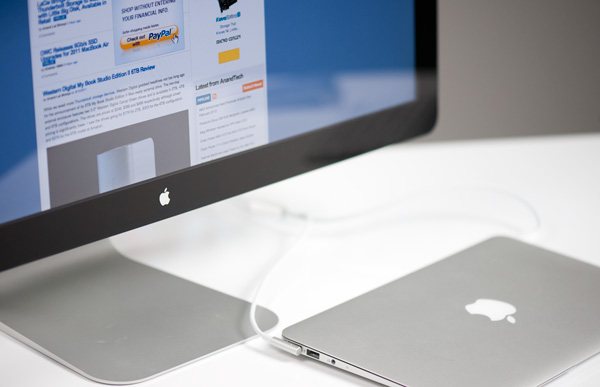
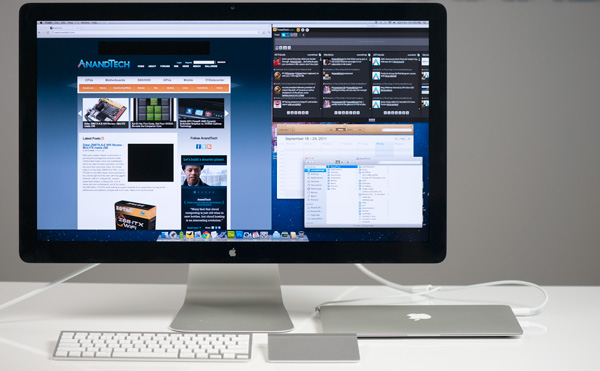
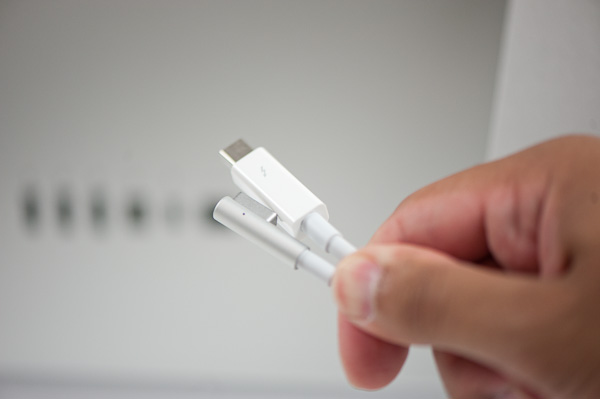








275 Comments
View All Comments
GotThumbs - Friday, September 23, 2011 - link
Anand,Love the Video Review format. While I think the product is nice and provides access to new tech, I have issues with Apples proprietary format. During a time where many users are going with multi-monitor configurations (I use dual Dell 30" monitors at work). I think combining functionality in a monitor limits/restricts users down the road. I would have liked to see purhaps an external Thunderbolt expansion system that would mount on the back of ANY monitor (via vesa). This would allow users the flexibility to upgrade/swap monitors as needed/desired. In today's technological world, we should be embracing expansion flexibility instead of restriction. It just seems to me that Apple continues to breed products that are proprietary in nature. Reminds me of the old Packard Bell systems where much of the internal hardware was proprietary. Thanks, but no thanks.
Keep up the good work and best wishes.
PS. I've been an AnandTech reader since your HS days.
Constructor - Friday, September 23, 2011 - link
The TBD just adds to the capabilities of your machine, it doesn't take away from it. You can daisy-chain other Thunderbolt add-ons as you want.Nobody prevents anyone from making a multi-port extension box without a display built in. Apple just chose to do it this way. You can even combine both if you want (and once the other announced extension boxes becomne available).
Beyond Thunderbolt being owned by Intel, there's nothing proprietary about the TBD. It's apparently just a relatively straightforward implementation of some of TB's capabilities.
GotThumbs - Saturday, September 24, 2011 - link
Curious, So what other laptops use a MagSafe connector? Other than Apple of course.Whats also curious as Anand pointed out. Why did Apple CHOOSE to leave out USB 3? Next years version will most likely include this. Just seems more of the same tactics used by Apple to keep its consumers re-purchasing much of the same technology to gain one or two new features.
Same with Itouch, Iphone, and Ipad. Same IOS, two items (Itouch and Iphone) are identical for the most part, but one makes calls. The Itouch and Ipad are same but one has bigger screen. Just seems like Apple is more about 'reselling' similar products to the same consumers. How many people purchased an IPAD2 to replace their IPAD, so they could have the camera feature? Apple could have added the camera into the first version but chose not to. Apple has great marketing, but I'm just not wowed by it like many others.
I'll be interested in seeing Thunderbolt added to more PC component products.
Constructor - Sunday, September 25, 2011 - link
The display works exactly the same without connecting the MagSafe connector, but the charging function is indeed limited to MacBooks (iMacs and Mac minis also can't use it).And USB3 in all the PCs with Intel CPUs you see right now is always done by connecting an external USB3 controller to the CPU. In Macs the PCIe lines used for that are instead used to drive the Thunderbolt controller, which is much more valuable. Especially on mobile CPUs with their limited supply of PCIe lanes it would probably not even be possible to drive both.
The next generation of Intel CPUs will provide USB3 directly anyway – and Apple will be able to provide both TB and USB3 at the same time.
To the iPad: I've got an iPad 1 and have not felt any compulsion to replace it with an iPad 2, particularly not for the cameras (the much faster processor and lighter weight would have been a better argument).
Apple keeps updating their product lines, and customers decide for themselves when to buy and when not to. Only relatively few actually jump to the next generation immediately. Most skip one or more generations.
Apple was extremely aggressive in hitting their target price of $499 with the iPad, and they actually made it. Just look at the competition and their difficulties in undercutting Apple there.
It is easy to clamour for them to have included everything and the kitchen sink right away, but that is unrealistic for pricing, development capacity and other reasons.
KoolAidMan1 - Sunday, September 25, 2011 - link
There is nothing proprietary about Thunderbolt. The technology was co-developed by Intel and Apple, and unlike USB the mini-DisplayPort connector has no license fees or usage restrictions associated with it. There is a huge difference between being proprietary and brute forcing a new technology that very few others are using at the moment. This isn't the first time Apple dumped legacy connectors in favor of a new technology.Either way, Thunderbolt will be adopted by more and more PC motherboards and laptops in 2012. There is talk of it being a pretty standard part of Ivy Bridge mobos, crossing fingers.
mlrabbitt - Friday, September 23, 2011 - link
Another +1 for the video review. I would prefer this over the "Conclusion" sections of all your reviews.Conficio - Friday, September 23, 2011 - link
I can' see how I have reduced the cables to my laptop now , but all the extensions are still a dangle of calbes, that even the "cable manage" hardly covers.Why is this not offered in a way where you have bays where storage, or other extensions can be hidden into. Or some sort of back mounting system for this.
In the same vain, where is the rest for the closed laptop on this one or the charging of the wireless keyboard?
I'm also missing some bluetooth for those that want to use wireless headsets.
And the future might just cut the second cord by having an inductive charging matt. Although I guess a laptop needs too much power for that.
Constructor - Friday, September 23, 2011 - link
All Macs already come with Bluetooth. Having another BT interface in the display for the same system would just cause interference without any benefit.And where would the inductive charging mat get its power from, if not through yet another a cable...? ;-)
Shadowmaster625 - Friday, September 23, 2011 - link
What happens when you unplug or lose communication with a pci express card while its interrupt is being serviced? Most likely a blue screen of death. It has always been a source of irritation, but that comes hand in hand with being able to buy low cost products. There is no way to code for every possible fault scenario and also meet any kind of budget.Constructor - Friday, September 23, 2011 - link
Thunderbolt-capable drivers will certainly need to survive device disconnection without blowing up the kernel. But beyond that, there should be little need for modification, if any.